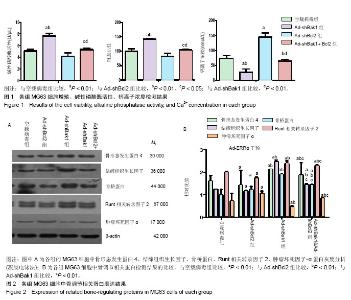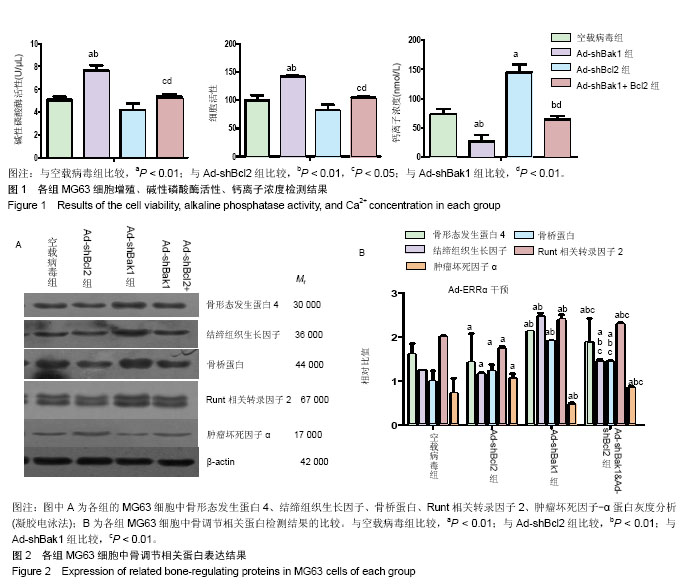| [1] Eastell R, O'Neill TW, Hofbauer LC, et al. Postmenopausal osteoporosis.Nat Rev Dis Primers.2016:16069.[2] Deblois G, Giguere V. Functional and physiological genomics of estrogen-related receptors (ERRs) in health and disease. Biochim Biophys Acta. 2011;1812:1032-1040.[3] Vanacker JM, Delmarre C, Guo X, et al. Activation of the osteopontin promoter by the orphan nuclear receptorestrogen receptor related ALP ha. Cell Growth Differ. 1998;9: 1007-1014.[4] Wensveen FM, Alves NL, Derks Ingrid AM, et al. Apoptosis induced by overall metabolic stress converges on the Bcl2 family proteins Noxa and Mcl-1.Apoptosis. 2011;16(7): 708-721.[5] Weitzmann MN, Pacifici R. Estrogen deficiency and bone loss: an inflammatory tale. J Clin Invest. 2006;116:1186-1194.[6] 杨先文,黄宏兴,万雷,等.Bcl2和Bak基因沉默对MG63细胞凋亡和成骨活动的影响[J].实用医学杂志,2017,33(17):2813-2816.[7] Mootha VK, Handschin C, Arlow D, et al. ErrALPha and Gabpa/b specify PGC-1 ALP ha-dependent oxidative phosphorylation gene expression that is altered in diabetic muscle. Proc Natl Acad Sci U S A. 2004 ;101(17):6570-5. [8] [bonnelye E, Aubin J E. Estrogen receptor-related receptor ALP ha: A mediatorofestrogen response in bone.Clin EndocrinolMetab.2005;90:3115.[9] bonnelyeE, LaurinN, JurdicP, et al. Estrogen receptor-related receptor-ALPha (ERR-ALP ha) is dys regulated in inflammatory arthritis.Rheumatology.2008;47:1785.[10] Schreiber SN, Emter R, Hock MB, et al. The estrogen-related receptor ALPha (ERRALPha) functions in PPARgamma coactivator 1 ALPha(PGC-1ALP ha)-induced mitochondrial biogenesis.Proc Natl Acad Sci U S A. 2004;101(17):6472-7. [11] Lin PI, Tai YT, Chan WP, et al. Estrogen/ER α signaling axis participates in osteoblast maturation via upregulating chromosomal and mitochondrial complex gene expressions. Oncotarget.2018;9(1):1169-1186.[12] Shoukry A, Shalaby SM, Etewa RL, et al. Association of estrogen receptor β and estrogen-related receptor α gene polymorphisms with bone mineral density in postmenopausal women. Mol Cell Biochem.2015;405(1-2):23-31.[13] Huang T, Liu R, Fu X, et al. Aging reduces an err alp ha-directed mitochondrial glutaminase expression suppressing glutamine anaplerosis and osteogenic differentiation of mesenchymal stem cells. Stem Cells.2017; 35(2):411-424.[14] 王雪峰,何援利,付霞霏,等.慢病毒介导的Bcl-2基因对磷酰胺氮芥诱导人原代卵巢颗粒细胞凋亡的保护作用[J].南方医科大学学报,2012,32(7):932-936.[15] Kingsley DM. The TGF-βsuperfamily: New members, new receptors, and new genetictests of function in different organism. Genes Dev.1994;8:133.[16] Yamamoto H, Kurachi M, Naruse M, et al. BMP4 signaling in NPCs upregulates Bcl-xL to promote their survival in the presence of FGF-2. Biochem Biophys Res Commun. 2018; 496(2):588-593.[17] Hayashi M, Kim SW, Imanaka Yoshida K, et al. Targeted deletion of bMK1/ERK5 inAdult mice perturbs vascular integrity and leads to endothelial failure. J Clin Invest. 2004; 113(8):1138.[18] 童雪影,唐祖胜,陈敏,等.骨桥蛋白的增龄性变化对骨质疏松症的影响[J].中国老年保健医学,2015,13(4):42-43.[19] Mundy C, Gannon M. Connective tissue growth factor (CTGF/CCN2) negatively regulates BMP-2 induced osteoblast differentiation and signaling. J Cell Physiol.2014; 229(5):672-681.[20] Tsai HC, Su HL, Huang CY, et al. CTGF increases matrix metalloproteinases expression and subsequently promotes tumor metastasis in human osteosarcoma through down-regulating miR-519d.Oncotarget.2014;5(11): 3800-3812.[21] 高凌云,陈静,王愉惠,赵丙姣,刘月华.结缔组织生长因子增强BMP-2诱导的牙周膜细胞成骨分化[J].临床口腔医学杂志, 2017,33(6):336-339.[22] Deng L, Hu G, Jin L, et al. Involvement of microRNA-23b in TNF-α-reduced BMSC osteogenic differentiation via targeting Runt Runx2. J Bone Miner Metab.2017: 1-13.[23] David J P, Schett G. TNF and bone.J Curr Dir Autoimmun. 2010;11:135-144.[24] Liao L, Su X, Yang X, et al. TNF-α inhibits FoxO1 by upregulating mir-705 to aggravate oxidative damage in bone marrow-derived mesenchymal stem cells during osteoporosis. Stem Cells.2016;34(4): 1054-1067.[25] Onyango IG.Modulation of mitochondrial bioenergetics as a therapeutic strategy in Alzheimer's disease.Neural Regen Res. 2018;13(1):19-25.[26] Courtney MP, Darcy LJ, Eric R. Skeletal muscle mitochondria and aging:a review. J Aging Res.2012:1-20.[27] Aldakkak M, Stowe DF, Camara AKS. Ca2+ induced mitochondrial permeability transition pore opening is substrate-dependent. FASEB J.2013;27:1209.1.[28] Logan CV, Szabadkai G, Sharpe JA, et al. Loss-of-function mutations in MICU1 cause a brain and muscle disorder linked to primary alterations in mitochondrial calcium signaling. Nat Genet. 2014;46(2):188-193.[29] Ureshino RP, Rocha KK, Lopes GS, et al. Calcium signaling alterations, oxidative stress, and autophagy in aging.Antioxid Redox Signal.2014;21(1):123-137.[30] Audet-Walsh É, Giguére V. The multiple universes of estrogen-related receptorαandγin metabolic control and related diseases. Acta Pharmacol Sin. 2015;36: 51-61.[31] Chen P, Wang H, Duan Z, et al. Estrogen-related receptor ALP ha confers methotrexate resistance via attenuation of reactive oxygen species production and P53 mediated apoptosis in osteosarcoma cells. Biomed Res Int. 2014; 2014:616025. |

